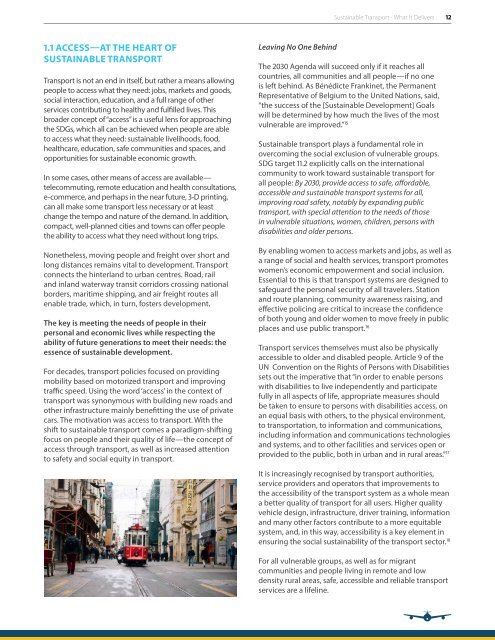MOBILIZING DEVELOPMENT
a5OQ306q56U
a5OQ306q56U
Create successful ePaper yourself
Turn your PDF publications into a flip-book with our unique Google optimized e-Paper software.
Sustainable Transport - What It Delivers 12<br />
1.1 ACCESS—AT THE HEART OF<br />
SUSTAINABLE TRANSPORT<br />
Transport is not an end in itself, but rather a means allowing<br />
people to access what they need: jobs, markets and goods,<br />
social interaction, education, and a full range of other<br />
services contributing to healthy and fulfilled lives. This<br />
broader concept of “access” is a useful lens for approaching<br />
the SDGs, which all can be achieved when people are able<br />
to access what they need: sustainable livelihoods, food,<br />
healthcare, education, safe communities and spaces, and<br />
opportunities for sustainable economic growth.<br />
In some cases, other means of access are available—<br />
telecommuting, remote education and health consultations,<br />
e-commerce, and perhaps in the near future, 3-D printing,<br />
can all make some transport less necessary or at least<br />
change the tempo and nature of the demand. In addition,<br />
compact, well-planned cities and towns can offer people<br />
the ability to access what they need without long trips.<br />
Nonetheless, moving people and freight over short and<br />
long distances remains vital to development. Transport<br />
connects the hinterland to urban centres. Road, rail<br />
and inland waterway transit corridors crossing national<br />
borders, maritime shipping, and air freight routes all<br />
enable trade, which, in turn, fosters development.<br />
The key is meeting the needs of people in their<br />
personal and economic lives while respecting the<br />
ability of future generations to meet their needs: the<br />
essence of sustainable development.<br />
For decades, transport policies focused on providing<br />
mobility based on motorized transport and improving<br />
traffic speed. Using the word ‘access’ in the context of<br />
transport was synonymous with building new roads and<br />
other infrastructure mainly benefitting the use of private<br />
cars. The motivation was access to transport. With the<br />
shift to sustainable transport comes a paradigm-shifting<br />
focus on people and their quality of life—the concept of<br />
access through transport, as well as increased attention<br />
to safety and social equity in transport.<br />
Leaving No One Behind<br />
The 2030 Agenda will succeed only if it reaches all<br />
countries, all communities and all people—if no one<br />
is left behind. As Bénédicte Frankinet, the Permanent<br />
Representative of Belgium to the United Nations, said,<br />
“the success of the [Sustainable Development] Goals<br />
will be determined by how much the lives of the most<br />
vulnerable are improved.” 15<br />
Sustainable transport plays a fundamental role in<br />
overcoming the social exclusion of vulnerable groups.<br />
SDG target 11.2 explicitly calls on the international<br />
community to work toward sustainable transport for<br />
all people: By 2030, provide access to safe, affordable,<br />
accessible and sustainable transport systems for all,<br />
improving road safety, notably by expanding public<br />
transport, with special attention to the needs of those<br />
in vulnerable situations, women, children, persons with<br />
disabilities and older persons.<br />
By enabling women to access markets and jobs, as well as<br />
a range of social and health services, transport promotes<br />
women’s economic empowerment and social inclusion.<br />
Essential to this is that transport systems are designed to<br />
safeguard the personal security of all travelers. Station<br />
and route planning, community awareness raising, and<br />
effective policing are critical to increase the confidence<br />
of both young and older women to move freely in public<br />
places and use public transport. 16<br />
Transport services themselves must also be physically<br />
accessible to older and disabled people. Article 9 of the<br />
UN Convention on the Rights of Persons with Disabilities<br />
sets out the imperative that “in order to enable persons<br />
with disabilities to live independently and participate<br />
fully in all aspects of life, appropriate measures should<br />
be taken to ensure to persons with disabilities access, on<br />
an equal basis with others, to the physical environment,<br />
to transportation, to information and communications,<br />
including information and communications technologies<br />
and systems, and to other facilities and services open or<br />
provided to the public, both in urban and in rural areas.” 17<br />
It is increasingly recognised by transport authorities,<br />
service providers and operators that improvements to<br />
the accessibility of the transport system as a whole mean<br />
a better quality of transport for all users. Higher quality<br />
vehicle design, infrastructure, driver training, information<br />
and many other factors contribute to a more equitable<br />
system, and, in this way, accessibility is a key element in<br />
ensuring the social sustainability of the transport sector. 18<br />
For all vulnerable groups, as well as for migrant<br />
communities and people living in remote and low<br />
density rural areas, safe, accessible and reliable transport<br />
services are a lifeline.


